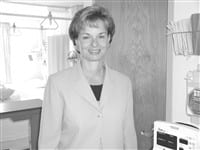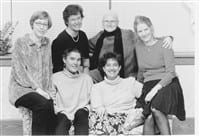Designs On A Better Infrastructure Of Care Cooley Dickinson Hospital Creates New Office of Clinical Affairs
Mary Beth Fairbrother admits that there is a certain amount of redundancy to the phrase ‘patient-centered care’ and a misleading sense in current literature that the concept is in some way new.
“That’s the phrase that everyone uses, and that’s what everyone is talking about today,” she said. “It drives me nuts in a way because isn’t that what we’ve always done — taken care of patients?”
That said, Fairbrother acknowledged that there are many different ways to provide patient-focused care, some more effective than others.
“If you were to line up 10 hospitals, each facility will probably have a different system of providing care and a different system of overseeing that care,” she explained. “It’s my understanding that what happened here was a recognition that the system in place did not allow things to happen on a simple, day-to-day basis. In other words, it wasn’t easy to provide that care.”
In her capacity as vice president of Patient Care at Cooley Dickinson Hospital, Fairbrother will work with Marc T. Edwards, M.D. to create a more efficient model for patient care delivery, one that will be streamlined and, therefore, better coordinated.
The two will comprise the hospital’s newly formed Office of Clinical Affairs, a department that will be charged with creating a structure for patient care delivery that will help ensure that quality of care does not suffer in these ultra-challenging times for all health care providers.
The Healthcare News looks this month at CDH’s new initiative and its broad goals for not only maintaining current levels of quality, but also improving them over time.
Dose of Reality
CDH President Craig Melin told The Healthcare News that the hospital’s Board of Trustees reorganized its governing structure in 2000 to make sure the trustees had additional oversight of quality care initiatives. One of the byproducts of that reorganization was the creation of the Office of Clinical Affairs, a body that will bring a new level of planning and organization to the broad task of quality control.
Fairbrother said the simply stated task for the new office is to create an infrastructure that will control the process, procedures, and protocols around how care is delivered to all patients — but there will be nothing simple about that assignment in the current health care environment.
Fairbrother, who arrived at CDH earlier this year, has spent the past several months getting to know the hospital, the staff, and its patient population, and starting to lay the groundwork for creating a new model for patient care delivery.
Melin said the hospital conducted a lengthy, national search for administrators to lead the new office and eventually chose Fairbrother, who has more than than 20 years of nursing experience at both teaching and community hospitals, and Edwards, who was most recently senior vice president and chief medical officer at Saint Peter’s University Hospital in Brunswick, N.J.
Fairbrother joined the hospital in February, while Edwards, vice president of Medical Affairs, was due to join the hospital in late July. Their assignment will be to bring a new, more coordinated approach to patient care.
Fairbrother said that until recently, CDH employed what is known as the ‘service-line’ approach to patient care, a system that was very much in vogue in the late ’80s and early ’90s. The service-line model essentially identified groups of patients with similar care needs and designed specific programs for meeting the needs of those groups.
One of those groups was surgical patients, she said, while another was for the hospital’s childbirth center, which focused on labor and delivery, postpartum, nursery, parent education, the Doula program, and other services that flowed in a linear pattern.
While the service-line format successfully identified specific needs of these patient groups, one of its weaknesses was that it didn’t promote communication between the different service lines, said Fairbrother, who told The Healthcare News that the desired model of patient care delivery provides for a seamless system of care.
“One of the challenges that this hospital recognized was that there was some fragmentation,” she said. “In my view, no matter where a patient is located in a hospital, the care should be seamless; it should be transparent to that patient.
“It shouldn’t make any difference whether the patient is in West 2 or West 3 or the Childbirth Center — they should have the same expectations about how care is delivered,” she continued. “And with the service line approach, that’s not always the case.”
Fairbrother said there is no name for the system that she and Edwards will be putting in place, and in reality, their goal is to impart a care philosophy more than an actual system.
“What’s happening in health care now is a realization that one size doesn’t fit everyone,” she said. “What we really need to do is look at what our patient population’s needs are and what our community’s needs are and then develop the model that fits within that structure.”
Clearing Hurdles
Complicating efforts to maintain and improve quality of patient care are the many challenges facing hospitals today, said Fairbrother, especially well-chronicled shortages of nurses, pharmacists, physical therapists, and other specialists. Planners have to understand these limitations and build into their care models large doses of flexibility and contingencies, she said.
“Those shortages are placing a great deal of strain on the system,” she said. “I can tell you what I would like to have in a patient care model, but that’s not possible in the year 2002. Therefore, when we create a model, we must combine a dose of reality with a vision of the future and integrate patient, family, and medical needs, and their psychosocial and educational needs all in one pot.”
She told The Healthcare News that the larger patient-care picture has a number of individual components. While the patient must naturally be at the center of the coordinated efforts, any patient-care infrastructure must also focus on giving caregivers all the tools they need to do their jobs and also concentrate on the needs of family members.
“We’re going to be focusing on how we deliver care and on the infrastructure that supports that delivery of care,” she continued. “If nurses are in short supply or pharmacists are in short supply, we’re going to look at what we can to eliminate from their day the extraneous duties that someone else might be able to accomplish that doesn’t require a professional.”
Advancing technology will also play a role in forming the new model, she said, adding that the hospital needs to determine where technology is taking health care and whether the facility is properly positioned to take advantage of that technology.
“It comes back to that notion of making care easier and seamless,” she explained. “To do that, you have to provide support to the people providing the care, and to families as well. There are many different layers to what we call patient care.”
Sorting through those layers will be a difficult, time-consuming process, she acknowledged, but the end result will be well worth the investment.


